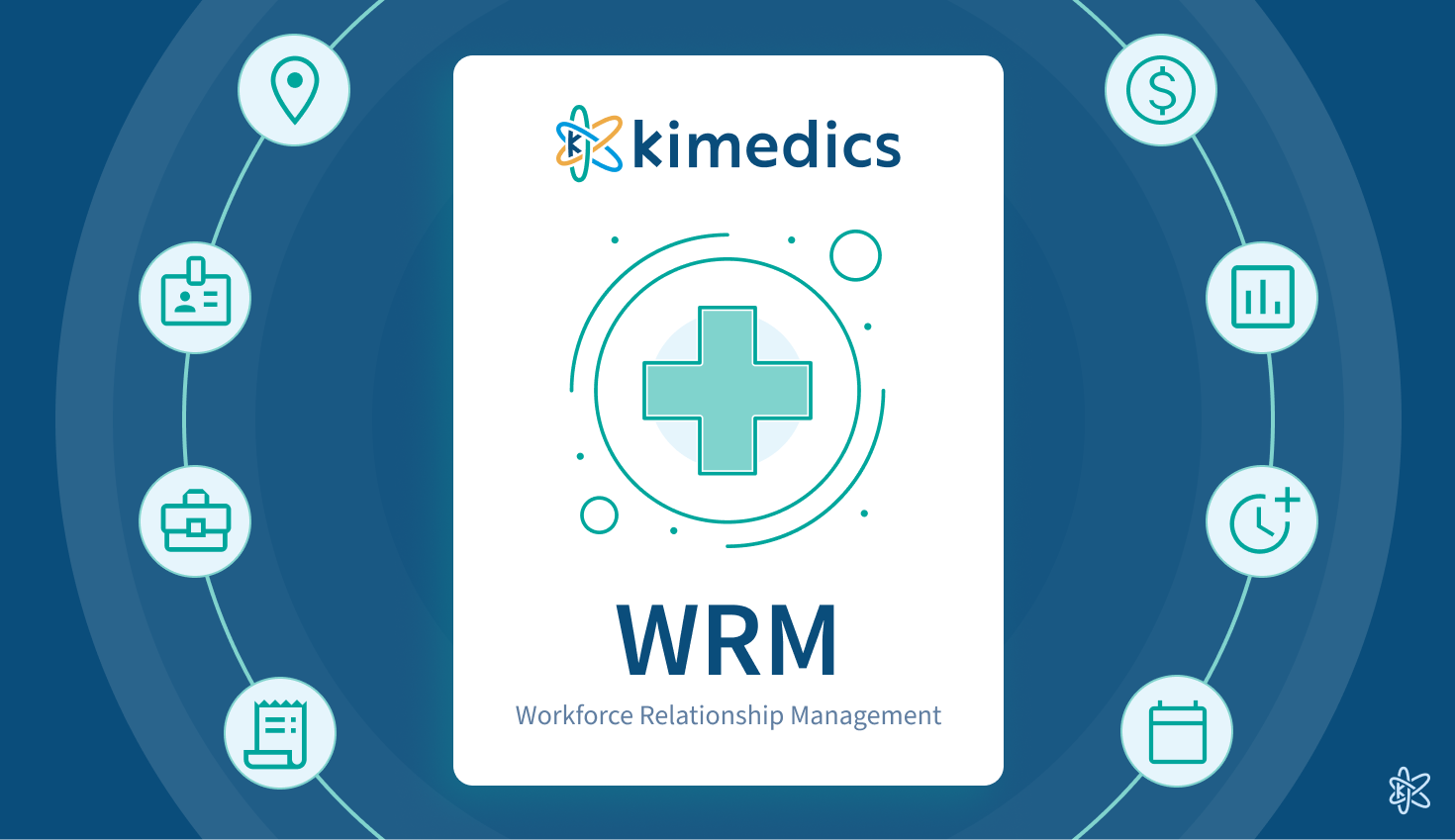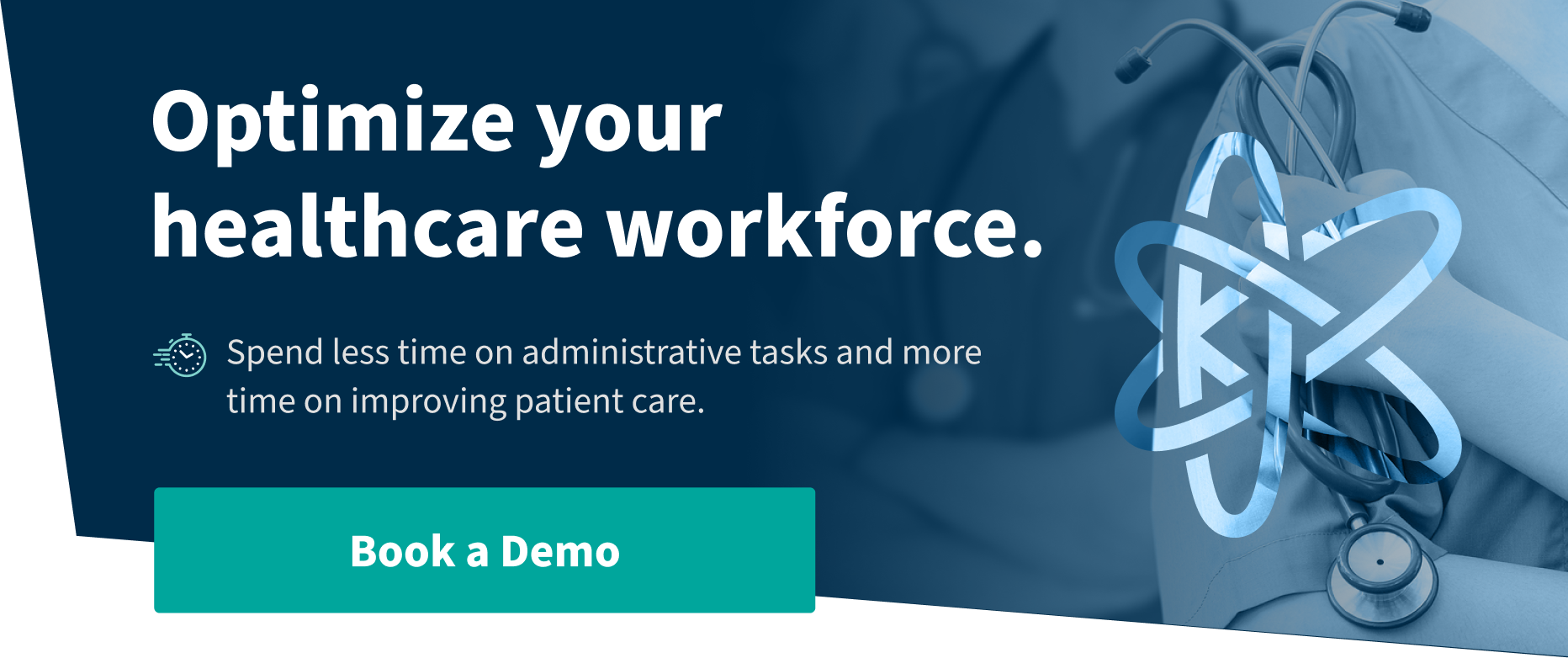Juggling a complex workforce across multiple locations while trying to deliver quality care is no easy feat. As a clinician, you need technology that can help, not hinder, the management of your team. That’s where workforce relationship management (WRM) software comes in.
WRM is a software platform built specifically for managing complex healthcare workforces. It's a centralized hub that connects your entire workforce, locations, credentials, schedules, and more in one intuitive platform. No more struggling with disjointed spreadsheets and data silos.
With WRM, you gain instant visibility into your workforce with easy access to profiles, documents, credentials, and assignments. Streamline scheduling, onboarding, payroll - you name it. Seamlessly collaborate across teams to align recruiting, finance, operations, and executives.
In a nutshell, a WRM platform helps you minimize frustrations so you can maximize patient care and clinician satisfaction. It's tailored for the unique workforce challenges in healthcare, not just a sales-focused CRM.
In this introductory guide, we’ll walk you through what a WRM is, why you need it, and how the right solution could help your organization. Let's dive in!
What is a WRM and Why Is It Needed?
What is a WRM, exactly? WRM stands for workforce relationship management. It is software specifically built to help manage complex workforces.
With WRM, you get a centralized hub that connects your entire workforce, locations, credentials, schedules, and more. The key features of a healthcare WRM are:
- Clinician profiles - Store all credentials and documents in one place. Get a holistic view of each clinician's skills, availability, and assignments.
- Location management - Manage clinician rosters, schedules, and details for each facility or practice site.
- Credentialing and privileges - Track credentials and link to location-specific privileges for seamless onboarding.
- Workflow automation - Streamline onboarding, scheduling, payroll and more with customizable checklists and workflows.
- Collaboration - Foster seamless communication across recruiting, scheduling, finance and other teams.
- Analytics - Gain real-time insights with dashboard reporting on productivity, retention, labor costs, and more.
Why WRM is a Must-Have for Healthcare Organizations
Traditional CRM systems fall short when it comes to managing healthcare's complex workforce needs across multiple locations and roles. WRM provides tailored tools to:
- Connect silos - Unite your currently disjointed systems and data sources. Remove frustrating communication barriers between departments.
- Enhance efficiency - Automate tedious manual processes like onboarding and scheduling. Access real-time clinician availability and assignments rather than relying on spreadsheets.
- Improve clinician experience - Provide self-service access to schedules, payroll, and benefits. Make it easy for clinicians to complete requirements and communicate with managers.
- Elevate care - Foster collaboration between clinicians, executives, finance and operations to align on providing quality care.
- Drive growth - Use data and insights to accurately forecast staffing needs, control labor costs, and recruit top talent.
WRM is purpose-built for the unique workforce challenges in healthcare. It's the missing link to connect your teams, maximize resources, and take patient care to the next level.
How a WRM is Different from CRM
Workforce relationship management (WRM) solution and a traditional customer relationship management (CRM) solution may seem similar at first glance, but they serve very different purposes.
A CRM, like Salesforce for example, focuses primarily on managing sales interactions and pipelines. A WRM on the other hand is tailored for complex workforce management.
Below are some of the key differences between the two types of software.
Relationships Tracked
A WRM can track things like complex credentialing/employment relationships like privileging status at different facilities, state license, clients, staffing suppliers, pay/bill rates, etc. Traditional CRM systems track sales interactions across contacts, companies and deals.
Tools Provided
A WRM likely features scheduling, onboarding, and payroll tools. CRMs on the other hand feature tools like contact management, and pipeline tracking.
Workflows Supported
Onboarding, credentialing, and scheduling are best managed with a WRM. They are also highly customizable to unique workflows.
Lead nurturing and opportunity stages are handled with a CRM. They often feature limited customization options as well.
Data Tracked
WRM systems track things like the skills, availability, and productivity of the members of your workforce. This makes a WRM an ideal solution for supporting your recruiting, finance, and operations teams.
A CRM helps you track emails sent and received, call logs, the value of deals, etc… This is precisely why sales and marketing teams love CRMs.
Purpose
The purpose of a WRM is to optimize workforce utilization and costs. On the other hand, the goal of a CRM is to increase sales and revenue.
In summary, WRM is focused on coordinating and managing people, skills, schedules, costs, and productivity across an organization. CRM centers on tracking sales interactions and pipeline.
While CRM excels at driving revenue, it falls short when it comes to the complexities of healthcare workforce management. WRM offers the tailored tools and customizability healthcare organizations need.
The Benefits of Leveraging a WRM
How can implementing a workforce relationship management help your healthcare organization? Transitioning to a dedicated WRM platform might seem like a big change, but the benefits for your healthcare organization are immense.
Connect Silos, Improve Alignment
- Break down data and communication silos between teams
- Provide transparency into workforce data to enable collaboration
- Align recruiting, operations, finance, executives on shared goals.
Enhance Efficiency and Costs
- Automate tedious manual workflows like onboarding and tracking privileging and credentialing
- Reduce overhead costs associated with spreadsheets and outdated systems
- Optimize clinician scheduling and productivity to control labor costs
Boost Clinician Retention
- Improve clinician experience via self-service and mobility
- Strengthen clinician-manager relationships through better communication
- Gain insight into retention risk factors like engagement and burnout
Elevate Client and Vendor Relationships
- Foster collaboration with client and vendor portals
- Deliver transparency into clinician assignments, schedules, availability
- Build trust and loyalty through a partnership approach.
Enhance Patient Care
- Connect clinicians to enable better coordination and teamwork
- Reduce clinician fatigue by optimizing schedules and workload
- Focus clinician time on delivering excellent care rather than admin tasks.
Drive Proactive Management
- Leverage analytics and dashboards for data-driven forecasting and planning
- Identify trends and issues early for rapid response
- Continuously refine workflows and processes to improve operations.
The bottom line? WRM empowers you to create a thriving workforce while increasing administrative workforce efficiency.
Key Features of Healthcare WRM Solutions
Now that you know the immense benefits of implementing a WRM solution in your healthcare organization, let’s explore some of the key features that enable workforce management magic:
Unified Clinician Profiles and Documents
- Centralized profiles containing licenses, credentials, employment info
- Digital documentation storage and expiration tracking
- Skills, experience, and availability visibility.
Location and Roster Management
- Map clinician roster groups to locations and shifts
- Manage facility details like services, capacities, and vendors
- Understand clinician assignments across practice sites.
Configurable Workflows
- Automate onboarding with checklists and approvals
- Streamline scheduling, timesheets, and other processes
- Customize to your unique requirements and workflows.
Collaboration Tools
- Clinician self-service for shifts and time-off requests
- Client and vendor portals for schedule access
- Messaging and alerts to connect staff across locations.
Analytics and Reporting
- Interactive dashboards with productivity, cost, and retention KPIs
- Robust filtering to analyze trends and drill into details
- Forecasting to optimize staff planning and budgeting.
Mobility and Accessibility
- Intuitive modern interfaces responsive across devices
- Clinician self-service via mobile app
- 24/7 system availability to manage real-time workforce needs.
Leading WRM solutions like Kimedics are purpose-built to handle healthcare’s unique complexities. Get ready to transform workforce management at your organization!
The Time is Now for WRM - And the Best One is Kimedics
After reading this guide, it should be clear that WRM is a purpose-built solution for managing your healthcare organization's unique workforce challenges. Let's recap the key benefits:
Connect Your Teams
Our WRM breaks down silos to foster transparency and collaboration between recruiting, operations, finance, and executives. Unite your organization around shared workforce goals.
Improve Efficiency and Costs
Automate manual processes to reduce errors and control overhead costs. Optimize clinician scheduling and productivity to reduce labor expenses.
Boost Retention
Strengthen relationships and improve clinician experience through mobility, self-service, and engagement. Proactively identify and address burnout.
Enhance Patient Care
Increase administrative workforce efficiency. This in turn enables clinicians to focus on patients rather than admin tasks.
Drive Data-Based Decisions
Leverage real-time analytics to inform forecasting, planning, and process improvements. Be proactive rather than reactive.
KPIs Tracked with Kimedics WRM
Just some of the KPIs you can track with our WRM include, but certainly isn’t limited to:
- Clinician acquisition cost
- Clinician retention rate
- Days to fill shifts
- Shift fill rate
- Clinician satisfaction
- Patient satisfaction
- Labor cost per hour
- Clinician productivity
- Privilege utilization
- Contract labor usage.
With the ability to easily track and report KPIs like this, you can improve your bottom line, improve the quality of care, and keep your workforce happier.
What are you waiting for? Now is the time to try Kimedics!
The pressure has never been higher to maximize constrained workforces, control costs, and deliver quality care. WRM provides the tools to rise to the challenge.
To get started, we recommend you clearly outline your organization's pain points and ideal workflows. Then, contact us for a demo of our solution to learn how we can help you streamline everything from scheduling to payroll.
At Kimedics, we prioritize ease of use, data security, and healthcare experience. Our platform is also cloud-based eliminating the need to install software on dozens if not thousands of computers and mobile devices! With the right platform in place, you'll be set up for workforce success - both now and in the future. Your patients, clinicians, and organization will reap the rewards.
Ready to schedule a demo of Kimedics workforce relationship management software? Click here!


